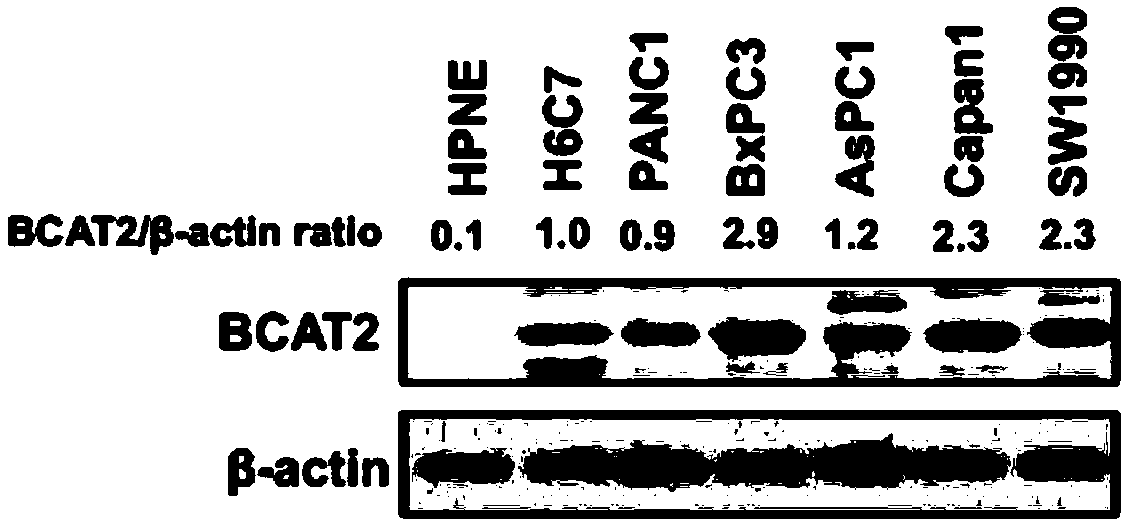Medical composition for preventing or treating pancreatic cancer and reagent kit for detecting pancreatic cancer
A composition and technology for pancreatic cancer, applied in the field of medicine and health, can solve the problems affecting pancreatic cancer, not clarified, etc., and achieve the effect of promoting the proliferation of pancreatic cancer cells
- Summary
- Abstract
- Description
- Claims
- Application Information
AI Technical Summary
Problems solved by technology
Method used
Image
Examples
Embodiment 1B
[0057] Example 1 BCAT2 promotes the proliferation of pancreatic ductal carcinoma cells
[0058] 1. The BCAT2 inhibitor sulfonylhydrazide BCAT2 inhibitor is used at a dose of 7.5 micromolar (μM), 30 μM, or 60 μM.
[0059] 2. Preparation of mouse models A transgenic mouse model with conditional knockout of Bcat2 was prepared, and Pdx1-cre; LSL-KRAS G12D (KC for short), Pdx1-Cre; Bcat were obtained by crossing different transgenic mice flox / flox and LSL-KrasG12D; Bcat2 flox / folx ; Pdx1-Cre (referred to as KCB) mouse model. The KC mouse model can well simulate the development process and pathological manifestations of pancreatic precancerous lesions PanIN (Hingorani et al., 2003), while the KCB mouse model can observe the impact of BCAT2 on the development of PanIN.
[0060] 3. To detect the effect of BCAT2 on the uptake of BCAA by pancreatic ductal epithelial cells and PDAC cells. The result is as Figure 17 and 22 As shown, stable overexpression of BCAT2 significantly incre...
Embodiment 2
[0066] Example 2 BCAT2 is significantly up-regulated in pancreatic cancer, thereby promoting BACC metabolism
[0067] To study the relationship between BCAA metabolism and pancreatic cancer, we focused on the first key enzyme involved in BCAA catabolism—branched-chain amino acid transaminase (BCAT). It includes two isoforms, BCAT1 located in the cytoplasm and BCAT2 located in the mitochondria. The relationship between branched-chain amino acid metabolism and pancreatic cancer was analyzed through the following extensive experiments.
[0068] 1. The protein levels of BCAT1 and BCAT2 were detected in immortalized normal pancreatic ductal epithelial cells and pancreatic ductal carcinoma cells, respectively. Two immortalized normal pancreatic ductal epithelial cells hTERT-HPNE and HPDE6C7 (hereinafter referred to as HPNE and H6C7) and five pancreatic ductal carcinoma cell lines were selected as the research objects. The protein levels of BCAT2 in pancreatic cells were detected b...
Embodiment 3
[0072] Example 3 KRAS activation mutation stabilizes BCAT2 protein
[0073] About 90% of pancreatic ductal carcinomas have KRAS activating mutations (Kanda et al., 2012). Therefore, we further investigated whether KRAS activating mutations regulate the protein level of BCAT2.
[0074] 1. Select three KRAS wild-type cell lines, namely H6C7, HPNE pancreatic ductal epithelial cells and BxPC3 cells, and overexpress the KRAS activating mutant (KRAS G12V) in these three cell lines, and found that the KRAS mutation up-regulates the BCAT2 protein level , but had no effect on the mRNA level of BCAT2. The KRAS activation mutant KRAS G12V was overexpressed in H6C7, HPNE and BxPC3 cells respectively, and the protein levels of KRAS knocked down in SW1990, PANC1 and AsPC1 cells, BCAT2 and KRAS were detected by WB. β-actin was quantified as endo. The mRNA expression level of BCAT2 in each cell line was detected by Q-PCR. n.s. means no significant difference. KRAS G12V up-regulated the p...
PUM
 Login to View More
Login to View More Abstract
Description
Claims
Application Information
 Login to View More
Login to View More - R&D
- Intellectual Property
- Life Sciences
- Materials
- Tech Scout
- Unparalleled Data Quality
- Higher Quality Content
- 60% Fewer Hallucinations
Browse by: Latest US Patents, China's latest patents, Technical Efficacy Thesaurus, Application Domain, Technology Topic, Popular Technical Reports.
© 2025 PatSnap. All rights reserved.Legal|Privacy policy|Modern Slavery Act Transparency Statement|Sitemap|About US| Contact US: help@patsnap.com



